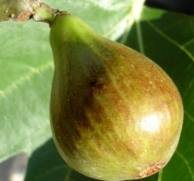Fig
Bacchus was thought to have acquired his vigour and corpulency from eating Figs, such as the Romans gave to professed wrestlers and champions for strength and good sustenance.
Added Jul 11, 2010
| 9,186 Reads
"In the name of the Prophet 'Figs'" was the pompous utterance ascribed to Dr. Johnson, whose solemn magniloquent style was simulated as Eastern cant applied to common business in Rejected Addresses, by the clever humorists, Horace and James Smith, 1812. The tree which produces this fruit belongs to the history of mankind. In Paradise Adam partook of figs, and covered his nakedness with the leaves. Though indigenous to Western Asia, Figs have been cultivated in most countries from a remote period, and will ripen in England during a warm summer if screened from north-east winds. The fig tree flourishes best with us on our sea coasts, bathed by the English Channel, by reason of the salt-laden atmosphere. Near Gosport, and at Fig Valleys, in the neighbourhood of Worthing, there are orchards of figtrees; but they remain barren in this country as far as affording seed to be raised anew from the ripened fruit. The first figtrees introduced into England are still alive and productive in the gardens of the Archbishop of Canterbury, at Lambeth, having been planted there by Cardinal Pole in the time of Henry the Eighth. We call the Sunday before Easter "Fig Sunday," probably because of our Saviour's quest of the fruit when going from Bethany the next day. By the Jews a want of blossom on the Fig tree was considered a grievous calamity. On the Saturday preceding Palm Sunday (says Miss Baker), the market at Northampton is abundantly supplied with figs, and more of the fruit is purchased at this time than throughout the rest of the year. Even charity children are regaled in some parts with figs on the said Sunday; whilst in Lancashire fig pies made of dried figs with sugar and treacle are eaten beforehand in Lent. In order to become fertilised, figs (of which the sexual apparatus lies within the fruit) must have their outer skin perforated by certain gnats of the Cynips tribe, which then penetrate to the interior whilst carrying with them the fertilising pollen; but these gnats are not found in this country. Producers of the fruit abroad bearing the said fact in view tie some of the wild fruit when tenanted by the Culex fly to the young cultivated figs. Foreign figs are dried in the oven so as to destroy the larvae of the Cynips insect, and are then compressed into small boxes. They consist in this state almost exclusively of mucilage and sugar. Only one kind of Fig comes to ripeness with us in England, the great blue Fig, as large as a Catherine pear. "It should be grown," says Gerard, "under a hot wall, and eaten when newly gathered, with bread, pepper, and salt; or it is excellent in tarts." This fruit is soft, easily digested, and corrective of strumous disease. Dried Turkey Figs, as imported, contain glucose (sugar), starch, fat, pectose, gum, albumen, mineral matter, collulose, and water. They are used by our druggists as an ingredient in confection of senna for a gentle laxative effect. When split open, and applied as hot as they can be borne against gumboils, and similar suppurative gatherings, they afford ease, and promote maturation of the abscess; and likewise they will help raw, unhealthy sores to heal. The first poultice of Figs on record is that employed by King Hezekiah 260 years before Christ, at the instance of the prophet Isaiah, who ordered to "take a lump of Figs; and they took it, and laid it on the boil, and the King recovered" (2 Kings xx. 7). The Fig is said to have been the first fruit, eaten as food by man. Among the Greeks it formed part of the ordinary Spartan fare, and the Athenians forbade exportation of the best Figs, which were highly valued at table. Informers against those who offended in this respect were called Suko phantai, or Fig discoverers—our Sycophants. Bacchus was thought to have acquired his vigour and corpulency from eating Figs, such as the Romans gave to professed wrestlers and champions for strength and good sustenance. Dodonoeus said concerning Figs, Alimentum amplius quam coeteri proebent; and Pliny spoke of them as the best restorative for those brought low by languishing disease, with loss of their colour. It was under the Perpul tree (Ficus religiosa) Buddha attained Nirvada. The botanical name ficus has been derived from the Greek verb phuo to generate, and the husbandry of Figs was called by the Latins "caprification." The little fig-bird of the Roman Campagna pays a yearly visit in September to the fig orchards on our Sussex coast. When eaten raw, dried Figs prove somewhat aperient, and they are apt to make the mouth sore whilst masticating them. Their seeds operate mechanically against constipation, though sometimes irritating the lining membrane of the stomach and bowels. Grocers prepare from the pulp of these foreign dried figs, when mixed with honey, a jam called "figuine," which is wholesome, and will prevent costiveness if eaten at breakfast with bread. The pulp of Turkey Figs is mucilaginous, and has been long esteemed as a pectoral emollient for coughs: also when stewed and, added to ptisans, for catarrhal troubles of the air passages, and of other mucous canals. In its fresh green state the fruit secretes a mildly acrid juice, which will destroy warts; this afterwards becomes saccharine and oily. The dried Figs of the shops give no idea of the fresh fruit as enjoyed in Italy at breakfast, which then seem indeed a fruit of paradise, and which contain a considerable quantity of grape sugar. In the Regimen of the School of Salerno (eleventh century) we read:— "Scrofa, tumor, glandes, ficus cataplasma sedet, Barley water boiled with dried Figs (split open), liquorice root, and raisins, forms the compound decoction of barley prescribed by doctors as a capital demulcent; and an admirable gargle for inflamed sore throat may be made by boiling two ounces of the Figs in half-a-pint of water, which is to be strained when cool. Figs cooked in milk make an excellent drink for costive persons. In the French codex a favourite pectoral medicine is composed of Formerly the poisoned Fig was used in Spain as a secret means for getting rid of an enemy. The fruit was so common there that to say "a fig for you!" and "I give you the fig" became proverbial expressions of contempt. In fiocchi (in gala costome), is an Italian phrase which we now render as "in full fig." The Water Figwort, a common English plant which grows by the sides of ditches, and belongs to the scrofula-curing order, has acquired its name because supposed to heal sores in the fundament when applied like figs as a poultice. It further bears the name of Water Betony (page 50), under which title its curative excellence against piles, and for scrofulous glands in the neck has been already described. The whole plant, yielding its juice, may be blended with lard to be used as an ointment; and an infusion of the roots, made with boiling water, an ounce to a pint, may be taken as a medicine—a wineglassful three times in the day. In Ireland it is known as "Rose noble," also as Kernelwort, because the kernels, or tubers attached to the roots have been thought to resemble scrofulous glands in the neck. "Divers do rashly teach that if it be hanged about the necke, or else carried about one it keepeth a man in health." In France the sobriquet herbe du seige, given to this plant, is said to have been derived from its famous use in healing all sorts of wounds during the long siege of Rochelle under Louis XIII. The Water Figwort may be readily known by the winged corners of its stems, which, though hollow and succulent, are rigid when dead, and prove very troublesome to anglers. The flowers are much frequented by wasps: and the leaves are employed to correct the taste of senna.
Added Jul 11, 2010
| 9,186 Reads
Share The Magic ...
The GoE MONEY!!! Course - A Course In Real MONEY MAGIC!
|





















